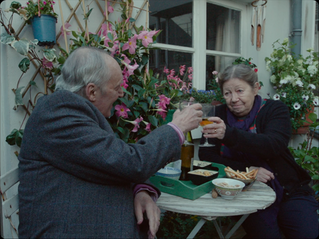Sous le Sable: a Realistic Portrayal of Grief
- Rhea Rajani
- Jan 20, 2020
- 3 min read
Updated: Oct 28, 2020

From the first scene, Sous le Sable plunges its audience into the complicated marriage of Jean (Bruno Cremer) and Marie Drillon (Charlotte Rampling), and we recoil at the awkward silences and exchanges between them. Yet, their introduction ends abruptly when Jean goes missing, and upon the discovery of his absence, it is unknown to Marie and the audience whether or not he is dead or alive. Marie is forced to return home without the knowledge of her husband’s whereabouts, and from this moment on, we begin to experience her retreat to the edge of madness, and her refusal to meet grief with reality.
Death and mourning begin to thematise the narrative. Orbiting Marie’s suffering, living with the uncertainty of her husband’s death, Sous le Sable is rendered both captivating and devastating in simultaneity.
the inability to ‘see’ death
Marie continues to adopt the present tense when speaking about Jean, and while her friends try to correct her, she continues incorrectly and in denial of his pastness, ignoring their criticism. She finds herself a dress, and for him, a tie, to satiate the need to buy him something and therefore somehow undo his absence. We discover that she cannot afford both, and she poignantly chooses the tie over the dress in an attempt to urge his existence into being.
Jean appears in the shadows and acts as a comfort for Marie as she longs for help or advice. Except, Marie cannot identify or see Jean’s body, thus she is pushed towards a state of un-acceptance and fantasy. Marie’s inability to ‘see’ Jean’s disappearance from her life is not only depicted symbolically, with a tie, but cinematically; through hallucinations of his persona. Jean is exposed to the audience before Marie, confirming that we occupy her unstable psychology alongside her, distorting and complicating the narrative entirely. In this way, and by way of Marie’s hallucinations, Jean is crafted as an inexplicable character, one shrouded with mystery. His presence somewhat remains in Marie’s life after the disappearance, and questions are raised as to whether or not he is dead or alive, a hallucination or a certainty; his character becomes a visual commentary of the indistinguishability of reality and ambiguity that emerges from grief.

grief as doubt
After his disappearance, Marie starts to question whether Jean was ever happy in their marriage. It is revealed that throughout their marriage Jean was taking antidepressants, leading her to question the subtext of his death and their relationship; is it her fault he is dead? Was his death an act of suicide? Marie begins to doubt the foundations of their entire relationship, and in doing so, opens up another spectrum in their marriage mediated by memory.
Essentially, it is through Jean’s character as a vehicle that Ozon is able to effectively portray the fragility of human existence and the destabilising effects of human loss. We watch as Marie struggles to accept the reality of death. She encapsulates the complications that grief entails, one being the sense of doubt towards existing memories, and the process of entirely skewing them into events created in one’s mind.

Sous le Sable visualises a reality of loss, bereavement and denial. Its end does not offer a stable conclusion, and we the audience certainly feel its obscurity. Despite the confirmation of Jean’s death, we see him in the final scene, Sous le Sable ends at a narrative standstill. Perhaps here, Ozon aims to reflect the reality and longevity of death and its mourning. Grief always remains a part of life, though its reality is seldom explored with such nuance.








Comments